Reading: America in the Second World War
America in the Second World War
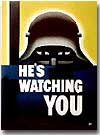
The fear of an Axis victory drove production levels to new heights during World War II. To help motivate American workers the U.S. Government commissioned posters such as this.
For the second time in the 20th century, the United States became involved in a devastating world conflict.
The mobilization effort of the government in WORLD WAR IIeclipsed even that of World War I. With major operations in both the Atlantic and Pacific theaters, American industries literally fueled two wars simultaneously. The social and economic consequences were profound. TheGREAT MIGRATION OF AFRICAN AMERICANS from the rural South to the industrial North was accelerated. New opportunities opened for women. Americans finally enjoyed a standard of living higher than the pre-Depression years.
But the war effort also had a darker side. Civil liberties were compromised, particularly for the 110,000 Japanese Americans who were forcibly uprooted from their West Coast homes to be sent to remote relocation camps.
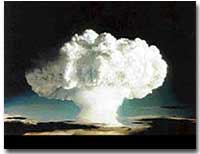
An atomic blast produces a distinctive "mushroom cloud." Developed by a top-secret U.S. government program dubbed the "Manhattan Project," the atomic bomb proved to be the weapon that ended World War II.
In both Europe and Asia, the Axis powers had established a firm foothold prior to American entry into the conflict. Slowly, but surely the Allies closed the ring on Nazi Germany after turning points at El Alamein andSTALINGRAD. Once Italy quit the Axis and the Allies landed successfully atNORMANDY, it was only a matter of time before the Nazi machine was smashed. Similar failures marked the early war in the Pacific, as the Japanese captured the Philippines. But once Japanese offensive capabilities were damaged at Midway, the United States "ISLAND HOPPED" its way to the Japanese mainland.
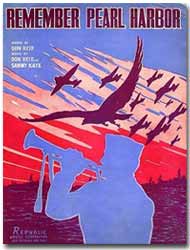
Shortly after America's entry into World War II, the patriotic song "Remember Pearl Harbor" hit the airwaves, urging America to "go on to victory."
New technologies emerged during the war as well. RADAR helped the British locate incoming German planes, and SONAR madeSUBMARINE detection much more feasible.GERMAN V-1 AND V-2 ROCKETS ushered in a new age of long-range warfare. But no weapon compared in destructive capacity to the atomic bomb, developed after a massive, secret research project spearheaded by the United States government.
World War II was fought over differences left unresolved after World War I. Over 400,000 Americans perished in the four years of involvement, an American death rate second only to the Civil War. Twelve million victims perished from Nazi atrocities in the HOLOCAUST. The deaths of twenty million Russians created a defensive Soviet mindset that spilled into the postwar era. After all the blood and sacrifice, the Axis powers were defeated, but the GRAND ALLIANCE that emerged victorious did not last long. Soon the world was involved in a 45-year struggle that claimed millions of additional lives — the Cold War.
Wartime Strategy
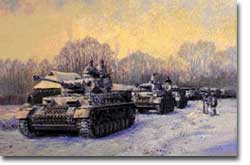
The winter of 1942 saw Russia defending Stalingrad from German capture. These German tanks aided in the battle, which ultimately left the city in ruins.
Three days after Congress declared war on Japan, Germany responded by declaring war on the United States.
Japan had an advance pledge of support from Hitler in the event of war with the United States. Now President Roosevelt faced a two-ocean war — a true world war. Despite widespread cries for revenge against Japan, the first major decision made by the President was to concentrate on Germany first. The American Pacific Fleet would do its best to contain Japanese expansion, while emphasis was placed on confronting Hitler's troops.
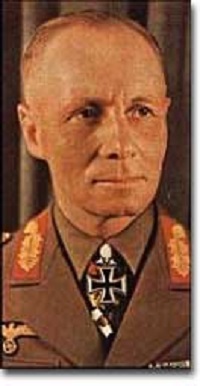
The vast military knowledge of German Field Marshal Erwin Rommel — known as "The Desert Fox" — was not enough to keep British and American forces from driving German troops from North Africa in late 1942.
Roosevelt believed that a Nazi-dominated Europe would be far more impregnable that any defenses Japan could build in the Pacific. American scientists worried that, with enough time, German scientists might develop weapons of mass destruction. Once Hitler was defeated, the combined Allied forces would concentrate on smashing Japanese ambitions.
American military leaders favored a far more aggressive approach to attacking Germany than their British counterparts. A cross-channel invasion of France from Britain would strike at the heart of Nazi strength, but the British command was dubious. Winston Churchill feared that should such an operation fail, the loss of human life, military resources, and British morale could be fatal.
Instead, Roosevelt and Churchill agreed to implement an immediate blockade of supplies to Germany and to begin bombing German cities and munitions centers. The army would attack Hitler's troops at their weakest points first and slowly advance toward German soil. The plan was known as "CLOSING THE RING." In December 1941, Roosevelt and Churchill agreed to attack German holdings in North Africa first.
That maneuver was finally executed in October 1942. Nazi troops were occupying much of the African Mediterranean coast, which had been controlled by France prior to the war. Led by BRITISH GENERAL BERNARD MONTGOMERY, British forces struck at German and Italian troops commanded by the "DESERT FOX," German FIELD MARSHAL ERWIN ROMMEL, at EL ALAMEIN in Egypt. As the British forced a German retreat, Anglo-American forces landed on the west coast of Africa on November 8 to stage a simultaneous assault. Rommel fought gamely, but numbers and positioning soon forced a German surrender. The Allies had achieved their first important joint victory.
Simultaneously, the Soviets turned the tide against Nazi advances into the Soviet Union by defeating the German forces at Stalingrad. When springtime came in 1943, the Allies had indeed begun to close the ring.
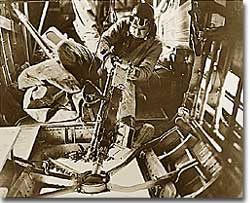
The first American air attack on European enemies came in August 1942. Here, a U.S. Air Force gunner uses a machine gun to fire at German planes.
Once Northern Africa was secured, the Allies took the next step toward Germany by launching invasions of Sicily and Italy. American and British leaders believed that when the Italian people faced occupation of their homeland, they would rise up and overthrow Mussolini. Fearing that the Allies would have a free road up to the border of Austria, German forces began to entrench themselves in Italy.
Despite German presence in Italy, Mussolini was arrested and the Italians surrendered to the Allies on September 3. There was no free road to Austria, however. German forces defended the peninsula ferociously, and even when the European war ended in May 1945, the Allies had failed to capture much of Italy.
The American Homefront
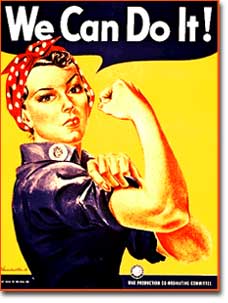
"Rosie the Riveter" served as both a symbol of women's contributions to the war effort as well as a call to others to join.
America was the largest military power in the world — in theory.
The large population, generous natural resources, advanced infrastructure, and solid capital base were all just potential. Centralization and mobilization were necessary to jump-start this unwieldy machine. Within a week of Pearl Harbor, Congress passed the WAR POWERS ACT, granting wide authority to the President to conduct the war effort. Throughout the war hundreds more alphabet agencies were created to manage the American homefront.
First the United States needed to enlarge its armed forces. Because of the peacetime draft, the UNITED STATES ARMED FORCES boasted over 1.5 million members. By the end of the war, that number rose to 12 million. A more expansive draft and a vigorous recruitment campaign produced these results. Prodded by ELEANOR ROOSEVELT, FDR created women's auxiliary forces for the army (WACS), navy (WAVES), air force (WASPS), and Coast Guard (SPARS). The colossal ranks of the armed services created a huge labor shortage.
Toward this end a "WORK OR FIGHT" propaganda campaign was waged. "ROSIE THE RIVETER" posters beckoned housewives to leave the home and enter the nation's factories. About 6.5 million females entered the workforce during the war years, many for the first time. African Americans continued the Great Migration northward, filling vacated factory jobs. Mexican Americans were courted to cross the border to assist with the harvest season in the BRACEROGUEST-WORKER PROGRAM. Thousands of retirees went back on the job, and more and more teenagers pitched in to fill the demand for new labor.

Posters like this encouraged Americans to conserve energy and resources by producing their own food.
The United States government spent over twice as much money fighting World War II as it had spent on all previous programs since its creation. Tax rates were raised to generate revenue and control inflation. Some people paid 90% of what they earned toward taxes!
Still, more money was needed so the government again launched Liberty andVICTORY LOAN DRIVES like those that helped finance the First World War. In addition, the size of the federal government more than tripled from about a million workers in 1940 to almost 3.5 million in 1945.
The United States managed to raise enough food and raw materials in the First World War through voluntary measures. This time, federal officials agreed that only through RATIONING could the demands be met. Americans were issued books of stamps for key items such as gasoline, sugar, meat, butter, canned foods, fuel oil, shoes, and rubber. No purchase of these commodities was legal without a stamp. VICTORY SPEED LIMITS attempted to conserve fuel by requiring Americans to drive more slowly. Rotating blackouts conserved fuel to be shipped overseas. Groups such as the Boy Scouts led scrap metal drives. Consumer goods like automobiles and refrigerators simply were not produced. Women drew lines down the backs of their legs to simulate nylon stockings when there were such shortages. Backyard gardens produced about 8 million tons of food.
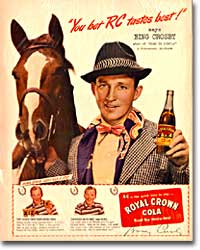
Crooners like Bing Crosby kept America smiling during the war with hits like "Goodbye Mama, I'm Off to Yokohama."
Additionally, the Office of War Information sponsored posters and rallies to appeal to patriotic heartstrings. Songs like BING CROSBY's "JUNK WILL WIN THE WAR" and"GOODBYE MAMA, I'M OFF TO YOKOHAMA"were on the lips of many Americans. Propaganda movies shot by famed directors such as FRANK CAPRA inspired millions.
The accomplishments of the American public were nothing short of miraculous. The navy had fewer than 5,000 vessels prior to the bombing at Pearl Harbor. By 1945, they had over 90,000. In addition, over 80,000 tanks and nearly 300,000 aircraft were produced during the war years. Millions of machine guns and rifles and billions of ammunition cartridges rolled off American production lines. New industries like synthetic rubber flourished, and old ones were rejuvenated.
At tremendous cost to the American taxpayer, the American people vanquished two evils: the AXIS POWERS and the Great Depression.
D-Day and the German Surrender
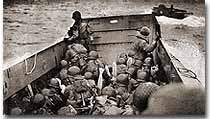
Hitler's refusal to surrender to the Allies led to "Operation Overlord" on June 6, 1944. British, Canadian, and American forces managed to take key points on the coast of Nazi-occupied France, signaling a beginning to the end of war in Europe.
The time had finally come. British and American troops had liberated North Africa and pressed on into Italy. Soviet troops had turned the tide at Stalingrad and were slowly reclaiming their territory. The ENGLISH CHANNEL was virtually free of Nazi submarines, and American and British planes were bombing German industrial centers around the clock.
Still, Hitler refused to surrender and hid behind his ATLANTIC WALL. Since the outbreak of war, Stalin was demanding an all-out effort to liberate France from German occupation. An invasion force greater than any in the history of the world was slowly amassing in southern Britain toward that end.
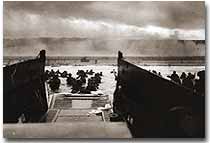
D-Day troops wade into the waist-deep water and onto the shore to face the enemy in battle.
A great game of espionage soon unfolded. If the Germans could discover when and where the attack would occur, they could simply concentrate all their efforts in one area, and the operation would be doomed to failure. The Allies staged phony exercises meant to confuse German intelligence. Two-dimensional dummy tanks were arranged to distract air surveillance. There was considerable reason to believe the attack would come at CALAIS, where the English Channel is narrowest. In actuality, OPERATION OVERLORD was aiming for the NORMANDY PENINSULA on the morning of June 4, 1944.
Foul weather postponed the attack for two days. Just after midnight on June 6, three airborne divisions parachuted behind enemy lines to disrupt paths of communications. As the German lookout sentries scanned the English Channel at daybreak, they saw the largest armada ever assembled in history heading toward the French shore. There were five points of attack. GOLD AND SWORD BEACHES were taken by the British, and JUNO BEACH was captured by Canadian forces. The American task was to capture UTAH AND OMAHA BEACHES. The troops at Omaha Beach met fierce resistance and suffered heavy casualties. Still, by nightfall a beachhead had been established. Eventually, German troops retreated.
After D-DAY, the days of the German resistance were numbered. Paris was liberated in August 1944 as the Allies pushed slowly eastward. Meanwhile, the Soviet Union was moving into German territory as well. Hitler, at the BATTLE OF THE BULGE, launched a final unsuccessful counteroffensive in December 1944. Soon the Americans, British, and Free French found themselves racing the Soviets to Berlin.
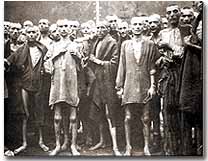
Following the defeat of the Nazi regime, the full extent of the Holocaust was at last revealed. These survivors of the Ebensee concentration camp were among the 250,000 liberated by Allied troops. Approximately 12,000,000 individuals were killed between 1933-45.
Along the way they encountered the depths of Nazi horrors when they discovered concentration camps. American soldiers saw humans that looked more like skeletons, gas chambers, crematoriums, and countless victims. Although American government officials were aware of atrocities against Jews, the sheer horror of the Holocaust of 12 million Jews, homosexuals, and anyone else Hitler had deemed deviant was unknown to its fullest extent.
When the Allies entered Berlin, they discovered that the mastermind of all the destruction — Adolf Hitler — had already died by his own hand. With little left to sustain any sort of resistance, the Germans surrendered on May 8, 1945, hereafter known as V-E (VICTORY IN EUROPE) DAY.
War in the Pacific
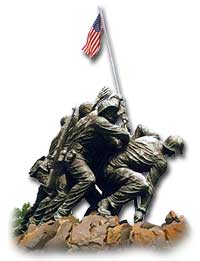
Located in Arlington, Virginia, this sculpture depicts the raising of the American flag over Iwo Jima and is dedicated to all Marines who have given their life in defense of the United States.
Defeating Germany was only part of America's mission.
Pearl Harbor was only the beginning of Japanese assaults on American holdings in the Pacific. Two days after attacking Pearl Harbor, they seized Guam, and two weeks after that they captured WAKE ISLAND. Before 1941 came to a close, the Philippines came under attack.
Led by GENERAL DOUGLAS MACARTHUR, the Americans were confident they could hold the islands. A fierce Japanese strike proved otherwise. After retreating to strongholds at BATAAN AND CORREGIDOR, the United States had no choice but to surrender the Philippines. Before being summoned away by President Roosevelt, General MacArthur promised: "I SHALL RETURN."
Before he returned however, the Japanese inflicted the BATAAN DEATH MARCH, a brutal 85-mile forced on American and Filipino POWs. 16,000 souls perished along the way.
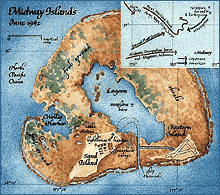
The map inset depicts the movements of both the Japanese and Allied forces during the Battle of Midway in June 1942.
In June 1942, Japan hoped to capture Midway Island, an American held base about 1000 miles from Hawaii. Midway could have been used as a staging point for future attacks on Pearl Harbor. The United States was still benefiting from being able to decipher Japanese radio messages. American naval commanders led by CHESTER NIMITZ therefore knew the assault was coming.
Airplane combat decided the BATTLE AT MIDWAY. After the smoke had cleared, four Japanese aircraft carriers had been destroyed. The plot to capture Midway collapsed, and Japan lost much of its offensive capability in the process. After the Battle of Midway, the Japanese were forced to fall back and defend their holdings.
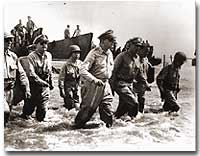
In 1941, Gen. Douglas MacArthur was forced to surrender the Philippines, but made his famous promise of "I shall return." Three years later, he made good on his promise to liberate the islands.
Island hopping was the strategy used by the United States command. Rather than taking every Japanese fortification, the United States selectively chose a path that would move U.S. naval forces closer and closer to the Japanese mainland. In October 1944, MacArthur returned to the Philippines accompanied by a hundred ships and soon the islands were liberated. The capture of IWO JIMA and OKINAWAcleared the way for an all-out assault on Japan. Despite heavy losses, the Japanese refused to surrender. They intensified the attacks on American ships with suicide mission KAMIKAZE flights.
In April 1945, President Roosevelt died of a brain hemorrhage, and HARRY TRUMAN was unexpectedly left to decide the outcome of the war in the Pacific.
Japanese-American Internment
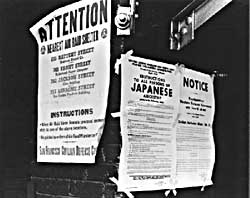
Many Americans worried that citizens of Japanese ancestry would act as spies or saboteurs for the Japanese government. Fear — not evidence — drove the U.S. to place over 127,000 Japanese-Americans in concentration camps for the duration of WWII.
Over 127,000 United States citizens were imprisoned during World War II. Their crime? Being of Japanese ancestry.
Despite the lack of any concrete evidence, Japanese Americans were suspected of remaining loyal to their ancestral land. ANTI-JAPANESE PARANOIA increased because of a large Japanese presence on the West Coast. In the event of a Japanese invasion of the American mainland, Japanese Americans were feared as a security risk.
Succumbing to bad advice and popular opinion, President Roosevelt signed an executive order in February 1942 ordering the RELOCATION of all Americans of Japanese ancestry toCONCENTRATION CAMPS in the interior of the United States.
Evacuation orders were posted in JAPANESE-AMERICAN communities giving instructions on how to comply with the executive order. Many families sold their homes, their stores, and most of their assets. They could not be certain their homes and livelihoods would still be there upon their return. Because of the mad rush to sell, properties and inventories were often sold at a fraction of their true value.
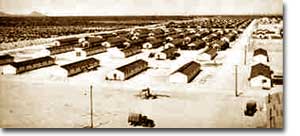
After being forced from their communities, Japanese families made these military style barracks their homes.
Until the camps were completed, many of the evacuees were held in temporary centers, such as stables at local racetracks. Almost two-thirds of the interns wereNISEI, or Japanese Americans born in the United States. It made no difference that many had never even been to Japan. Even Japanese-American veterans of World War I were forced to leave their homes.
Ten camps were finally completed in remote areas of seven western states. Housing was spartan, consisting mainly of tarpaper barracks. Families dined together at communal mess halls, and children were expected to attend school. Adults had the option of working for a salary of $5 per day. The United States government hoped that the interns could make the camps self-sufficient by farming to produce food. But cultivation on arid soil was quite a challenge.
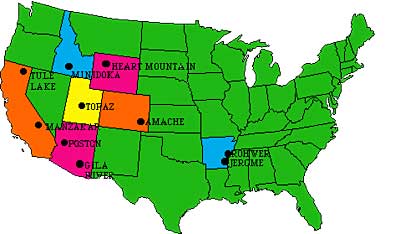
Most of the ten relocation camps were built in arid and semi-arid areas where life would have been harsh under even ideal conditions.
Evacuees elected representatives to meet with government officials to air grievances, often to little avail. Recreational activities were organized to pass the time. Some of the interns actually volunteered to fight in one of two all-Nisei army regiments and went on to distinguish themselves in battle.
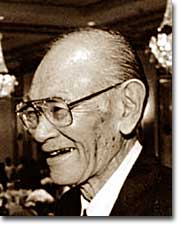
Fred Korematsu challenged the legality of Executive Order 9066 but the Supreme Court ruled the action was justified as a wartime necessity. It was not until 1988 that the U.S. government attempted to apologize to those who had been interned.
On the whole, however, life in the relocation centers was not easy. The camps were often too cold in the winter and too hot in the summer. The food was mass produced army-style grub. And the interns knew that if they tried to flee, armed sentries who stood watch around the clock, would shoot them.
FRED KOREMATSU decided to test the government relocation action in the courts. He found little sympathy there. In KOREMATSU VS. THE UNITED STATES, the Supreme Court justified the executive order as a wartime necessity. When the order was repealed, many found they could not return to their hometowns. Hostility against Japanese Americans remained high across the West Coast into the postwar years as many villages displayed signs demanding that the evacuees never return. As a result, the interns scattered across the country.
In 1988, Congress attempted to apologize for the action by awarding each surviving intern $20,000. While the American concentration camps never reached the levels of Nazi death camps as far as atrocities are concerned, they remain a dark mark on the nation's record of respecting civil liberties and cultural differences.
The Manhattan Project
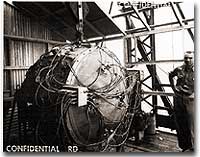
This once classified photograph features the first atomic bomb — a weapon that atomic scientists had nicknamed "Gadget." The nuclear age began on July 16, 1945, when it was detonated in the New Mexico desert.
Early in 1939, the world's scientific community discovered that German physicists had learned the secrets of splitting a uranium atom. Fears soon spread over the possibility of Nazi scientists utilizing that energy to produce a bomb capable of unspeakable destruction.
Scientists ALBERT EINSTEIN, who fled Nazi persecution, and ENRICO FERMI, who escaped Fascist Italy, were now living in the United States. They agreed that the President must be informed of the dangers of atomic technology in the hands of the Axis powers. Fermi traveled to Washington in March to express his concerns on government officials. But few shared his uneasiness.
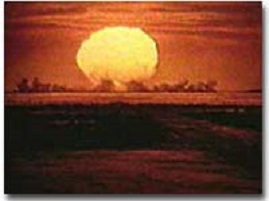
Leaving nothing to chance, Los Alamos atomic scientists conducted a pre-test test in May 1945 to check the monitoring instruments. A 100-ton bomb was exploded some 800 yards from the Trinity site where Gadget would be detonated a few weeks later.
Einstein penned a letter to President Roosevelt urging the development of an atomic research program later that year. Roosevelt saw neither the necessity nor the utility for such a project, but agreed to proceed slowly. In late 1941, the American effort to design and build anATOMIC BOMB received its code name — the MANHATTAN PROJECT.
At first the research was based at only a few universities — Columbia University, the University of Chicago and the University of California at Berkeley. A breakthrough occurred in December 1942 when Fermi led a group of physicists to produce the first controlled NUCLEAR CHAIN REACTION under the grandstands ofSTAGG FIELD at the University of Chicago.
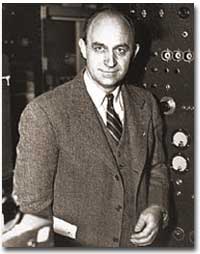
Enrico Fermi, a physicist who left fascist Italy for America, encouraged the U.S. to begin atomic research. The result was the top-secret "Manhattan Project."
After this milestone, funds were allocated more freely, and the project advanced at breakneck speed. Nuclear facilities were built at Oak Ridge, Tennessee and Hanford, Washington. The main assembly plant was built at LOS ALAMOS, NEW MEXICO. ROBERT OPPENHEIMER was put in charge of putting the pieces together at Los Alamos. After the final bill was tallied, nearly $2 billion had been spent on research and development of the atomic bomb. The Manhattan Project employed over 120,000 Americans.
Secrecy was paramount. Neither the Germans nor the Japanese could learn of the project. Roosevelt and Churchill also agreed that the Stalin would be kept in the dark. Consequently, there was no public awareness or debate. Keeping 120,000 people quiet would be impossible; therefore only a small privileged cadre of inner scientists and officials knew about the atomic bomb's development. In fact, Vice-President Truman had never heard of the Manhattan Project until he became President Truman.
Although the Axis powers remained unaware of the efforts at Los Alamos, American leaders later learned that a Soviet spy named KLAUS FUCHS had penetrated the inner circle of scientists.
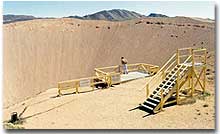
This crater in the Nevada desert was created a 104 kiloton nuclear bomb buried 635 feet beneath the surface. It is the result of a 1962 test investigating whether nuclear weapons could be used to excavate canals and harbors.
By the summer of 1945, Oppenheimer was ready to test the first bomb. On July 16, 1945, at TRINITY SITE nearALAMOGORDO, NEW MEXICO, scientists of the Manhattan Project readied themselves to watch the detonation of the world's first atomic bomb. The device was affixed to a 100-foot tower and discharged just before dawn. No one was properly prepared for the result.
A blinding flash visible for 200 miles lit up the morning sky. A mushroom cloud reached 40,000 feet, blowing out windows of civilian homes up to 100 miles away. When the cloud returned to earth it created a half-mile wide crater metamorphosing sand into glass. A bogus cover-up story was quickly released, explaining that a huge ammunition dump had just exploded in the desert. Soon word reached President Truman in Potsdam, Germany that the project was successful.
The world had entered the nuclear age.
The Decision to Drop the Bomb
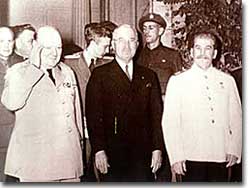
Winston Churchill, Harry Truman, and Josef Stalin meet at the Potsdam Conference. They discussed the post-war order and peace treaty issues.
America had the bomb. Now what?
When Harry Truman learned of the success of the Manhattan Project, he knew he was faced with a decision of unprecedented gravity. The capacity to end the war with Japan was in his hands, but it would involve unleashing the most terrible weapon ever known.
American soldiers and civilians were weary from four years of war, yet the Japanese military was refusing to give up their fight. American forces occupied Okinawa and Iwo Jima and were intensely fire bombing Japanese cities. But Japan had an army of 2 million strong stationed in the home islands guarding against invasion.
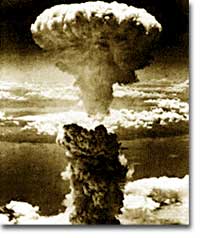
A "mushroom" cloud rises over the city of Nagasaki on August 9, 1945, following the detonation of "Fat Man." The second atomic weapon used against Japan, this single bomb resulted in the deaths of 80,000 Japanese citizens.
For Truman, the choice whether or not to use the atomic bomb was the most difficult decision of his life.
First, an Allied demand for an immediate unconditional surrender was made to the leadership in Japan. Although the demand stated that refusal would result in total destruction, no mention of any new weapons of mass destruction was made. The Japanese military command rejected the request for unconditional surrender, but there were indications that a conditional surrender was possible.
Regardless, on August 6, 1945, a plane called the ENOLA GAY dropped an atomic bomb on the city of HIROSHIMA. Instantly, 70,000 Japanese citizens were vaporized. In the months and years that followed, an additional 100,000 perished from burns and radiation sickness.
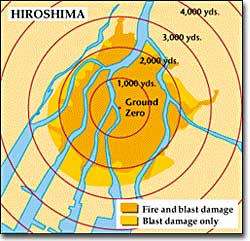
Two days later, the Soviet Union declared war on Japan. On August 9, a second atomic bomb was dropped on NAGASAKI, where 80,000 Japanese people perished.
On August 14, 1945, the Japanese surrendered.
Critics have charged that Truman's decision was a barbaric act that brought negative long-term consequences to the United States. A new age of nuclear terror led to a dangerous arms race.
Some military analysts insist that Japan was on its knees and the bombings were simply unnecessary. The American government was accused of racism on the grounds that such a device would never have been used against white civilians.
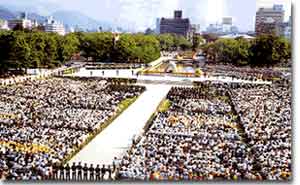
On August 6, the city of Hiroshima, Japan remembers those who lost their lives when the atomic bomb fell. Thousands attend the Hiroshima Peace Memorial Ceremony annually.
Other critics argued that American diplomats had ulterior motives. The Soviet Union had entered the war against Japan, and the atomic bomb could be read as a strong message for the Soviets to tread lightly. In this respect, Hiroshima and Nagasaki may have been the first shots of the Cold War as well as the final shots of World War II. Regardless, the United States remains the only nation in the world to have used a nuclear weapon on another nation.
Truman stated that his decision to drop the bomb was purely military. A Normandy-type amphibious landing would have cost an estimated million casualties. Truman believed that the bombs saved Japanese lives as well. Prolonging the war was not an option for the President. Over 3,500 Japanese kamikaze raids had already wrought great destruction and loss of American lives.
The President rejected a demonstration of the atomic bomb to the Japanese leadership. He knew there was no guarantee the Japanese would surrender if the test succeeded, and he felt that a failed demonstration would be worse than none at all. Even the scientific community failed to foresee the awful effects of RADIATION SICKNESS. Truman saw little difference between atomic bombing Hiroshima and FIRE BOMBING Dresden or Tokyo.
The ethical debate over the decision to drop the atomic bomb will never be resolved. The bombs did, however, bring an end to the most destructive war in history. The Manhattan Project that produced it demonstrated the possibility of how a nation's resources could be mobilized.
Pandora's box was now open. The question that came flying out was, "How will the world use its nuclear capability?" It is a question still being addressed on a daily basis.
